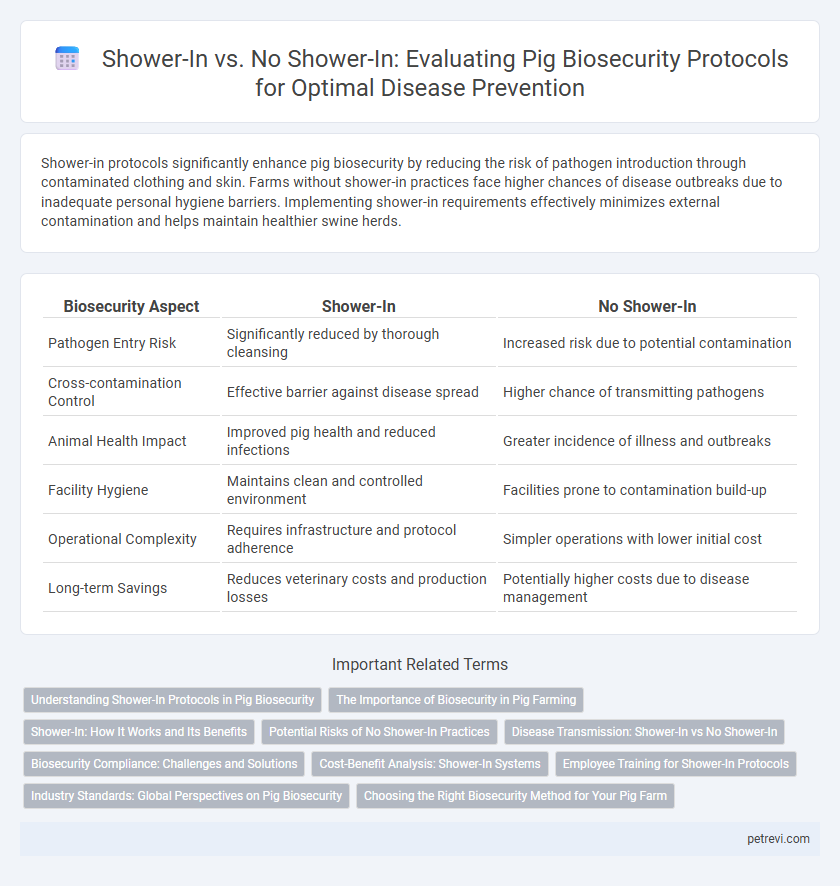Shower-in protocols significantly enhance pig biosecurity by reducing the risk of pathogen introduction through contaminated clothing and skin. Farms without shower-in practices face higher chances of disease outbreaks due to inadequate personal hygiene barriers. Implementing shower-in requirements effectively minimizes external contamination and helps maintain healthier swine herds.
Table of Comparison
| Biosecurity Aspect | Shower-In | No Shower-In |
|---|---|---|
| Pathogen Entry Risk | Significantly reduced by thorough cleansing | Increased risk due to potential contamination |
| Cross-contamination Control | Effective barrier against disease spread | Higher chance of transmitting pathogens |
| Animal Health Impact | Improved pig health and reduced infections | Greater incidence of illness and outbreaks |
| Facility Hygiene | Maintains clean and controlled environment | Facilities prone to contamination build-up |
| Operational Complexity | Requires infrastructure and protocol adherence | Simpler operations with lower initial cost |
| Long-term Savings | Reduces veterinary costs and production losses | Potentially higher costs due to disease management |
Understanding Shower-In Protocols in Pig Biosecurity
Shower-in protocols in pig biosecurity require personnel to thoroughly cleanse and disinfect before entering pig housing areas to minimize the introduction of pathogens. Studies show that farms implementing shower-in procedures experience significantly lower incidences of respiratory and enteric diseases in swine populations. Eliminating shower-in protocols increases the risk of pathogen transmission, leading to compromised herd health, higher mortality rates, and reduced productivity.
The Importance of Biosecurity in Pig Farming
Implementing a shower-in system significantly enhances biosecurity in pig farming by reducing the risk of pathogen entry through contaminated clothing and footwear. Farms without shower-in protocols are more vulnerable to disease outbreaks, leading to increased mortality rates and substantial economic losses. Strict biosecurity measures, including shower-in practices, are critical for controlling infectious diseases and maintaining herd health in pig production.
Shower-In: How It Works and Its Benefits
Shower-in biosecurity protocols require personnel to thoroughly cleanse and disinfect before entering pig housing, significantly reducing pathogen transmission risk. Implementing shower-in systems helps maintain herd health by minimizing the introduction of diseases such as Porcine Reproductive and Respiratory Syndrome (PRRS) and African Swine Fever (ASF). This controlled hygiene barrier enhances overall biosecurity, leading to improved productivity and reduced veterinary costs.
Potential Risks of No Shower-In Practices
No shower-in practices in pig biosecurity significantly increase the risk of introducing pathogens such as Porcine Reproductive and Respiratory Syndrome Virus (PRRSV) and African Swine Fever Virus (ASFV) into swine facilities. Contaminated clothing, footwear, and skin can act as vectors, facilitating disease spread and causing severe outbreaks that impair herd health and productivity. Absence of mandatory shower-in protocols undermines biosecurity integrity, elevating potential financial losses due to disease management and reduced pork production efficiency.
Disease Transmission: Shower-In vs No Shower-In
Implementing a shower-in protocol significantly reduces disease transmission in pig facilities by eliminating pathogens on workers' skin and clothing before entering. Without shower-in measures, biosecurity weakens, increasing the risk of introducing viral agents like Porcine Reproductive and Respiratory Syndrome Virus (PRRSV) and African Swine Fever (ASF) into pig populations. Studies show that strict shower-in practices correlate with lower incidences of contagious swine diseases and improved herd health outcomes.
Biosecurity Compliance: Challenges and Solutions
Shower-in biosecurity protocols significantly reduce the risk of pathogen transmission in pig facilities by ensuring personnel remove contaminants before entry, which is critical for maintaining herd health and regulatory compliance. Challenges include infrastructure costs, time constraints, and resistance to behavioral change, impacting effective implementation. Solutions involve investing in automated shower systems, comprehensive staff training, and strict enforcement of entry procedures to enhance compliance and safeguard pig populations.
Cost-Benefit Analysis: Shower-In Systems
Shower-in systems for pig biosecurity reduce the risk of pathogen introduction by enforcing strict hygiene protocols, decreasing disease outbreaks and associated costs. Initial installation and maintenance expenses can be high, but the long-term benefits include fewer treatment costs, improved herd health, and enhanced production efficiency. Cost-benefit analysis shows that shower-in systems offer significant economic advantages by minimizing disease-related losses and supporting sustainable pig farming operations.
Employee Training for Shower-In Protocols
Employee training for shower-in protocols significantly enhances pig farm biosecurity by minimizing pathogen transmission through external contaminants on personnel. Comprehensive training programs emphasize proper shower-in hygiene practices, including thorough washing, changing into farm-only clothing, and adherence to designated entry procedures. Consistent reinforcement of these protocols reduces disease outbreaks and supports a healthier herd environment.
Industry Standards: Global Perspectives on Pig Biosecurity
Industry standards for pig biosecurity emphasize shower-in protocols to minimize pathogen transmission on farms. Global guidelines from organizations like the OIE and FAO recommend shower-in procedures as critical for reducing disease outbreaks, especially in intensive pig production systems. However, some regions adapt these standards based on local risk assessments, balancing biosecurity with operational feasibility.
Choosing the Right Biosecurity Method for Your Pig Farm
Choosing the right biosecurity method for your pig farm significantly impacts disease prevention and overall herd health. Shower-in protocols reduce the risk of pathogen introduction by ensuring farm personnel change into sanitized clothing and thoroughly wash before entering pig housing, minimizing contamination from outside sources. Farms without shower-in facilities rely heavily on alternative measures such as controlled access, footwear disinfection, and strict clothing policies to maintain biosecurity, but these may offer less comprehensive protection against external pathogens.
Shower-in vs No shower-in for Pig biosecurity Infographic

 petrevi.com
petrevi.com